Echoes Amplified: AI & My Symphony of Words and Images

I love writing. It’s a love affair I’ve had for most of my life.
When I get into the flow of a piece, a thousand words or more can fly by in an instant. What slows me down is doing research to support my writing. Finding the sources is a drag, finding the relevant information within the sources, an even bigger drag.
AI has put air under the drag, lifted it up and allowed smoother forward movement for all my creativity. Not just my writing. Since May 2023, I’ve had a project running that I now call “Reflective Echoes”. I’ve not talked much about it nor the creation process I use.
What Are Reflective Echoes?
They start with a single word, become an image to represent the word, then a quote to represent the image, and finally, a reflection written about the quote. They reflect my perspective of my journey of introspection and spirituality. Everyone’s journey is personally their own. In our interconnected universe, there is overlap and points of agreement.
I share my reflective echoes in the hope they support your journey.
The Evolution of Reflective Echoes
Echoes started out as an exercise to hone my prompt writing for Midjourney. I used a different word each day with the goal of creating an image to represent the word. The randomly chosen words present a challenge to represent them visually.
I turned to Chatgpt to provide reference information like: definition, etymology, interesting facts, symbology, colours and textures related to the word. AI gave me clues, but not the help I actually needed. I started developing prompts and a process to give me enough reference material to spark my own thinking processes.

I found some days I would generate more than one image to use for the word. Some days I struggled to get a sense of what would represent the word; directly, symbolically, or even metaphorically. When I started adding the quotes, I often found myself uncertain if I was communicating the message appropriately.
I created prompts for that.
In August, I started writing brief reflections on the quotes and soon found a pull to go deeper, to challenge myself to not only think deeper, but to understand more about how the concepts resonated within the wisdom traditions and by well-known figures.
More prompts were created.
ChatGPT is my primary AI tool. It’s my virtual assistant. I use it to gather material for me to create and write with. It doesn’t do my writing for me.
Parting the Curtain On My Process
I’m writing this post for the Creative Work Hour and DreemPort collaboration for February. The challenge is to write a more in-depth post on a topic than I would normally do. It seemed like a good time to do something many had asked me about. Talk about how I create the Daily Echoes and Reflections that make up Reflective Echoes.
The Daily Echo is the image and quote you see shared each day on DBuzz, Twitter, Facebook, Instagram, etc. Soon, they will be available by email subscription. Subscribers will also receive a brief explanation of the meaning conveyed in the image and quote.
While I’ve been building my website infrastructure, I’ve not been publishing the Reflections. They are an in-depth exploration of the quote, looking at how it may be viewed by others and how it resonates with me. They will return soon as a paid subscription to help support my work.
My Tools
Every process needs tools. I’ll give you just the list here and explain them as I move through the process.
- Obsidian for my daily reference note
- Midjourney to create my images
- Generative text AI - Perplexity, ChatGPT, Pi and Gemini
- Prompts for ChatGPT
- Echo Word
- Echo Image Analyzer
- Echo Prompts
- Council of 5
- Spiritual Council
- Wisdom Traditions
- Wisdom Scholar
- Originality.ai

I’ll tell you about the prompts I’ve created, but I’m not sharing them. They are specific to what I’m doing and they will only increase the word count. Some of them are very long. Which is why I’ve created a private GPT for each prompt.
It Begins With A Word and A Note
The words are generated by AI when I create the prompts for my Prompt A Day email list. This is a set of creative prompts sent to subscribers daily.
I use Obsidian to write notes on material I gather on a wide range of topics. It is my daily dashboard where everything lives. I could write a whole post on why I like it, so let me not digress. Relevant to this post is that I have a template setup to use for each word.
The template gathers together all the text information I generate related to that day’s echo. I call it a reference note because it contains a lot more information than I will use. It’s there for me to refer to at any time. I’m able to go through and highlight important points and then add hashtags to turn them up when I search later.
Getting to Know the Word
Let’s explore a word I recently did - Komorebi
The Echo Word prompt defines the word, the etymology and interesting facts on how the word is relevant. I also have the prompt make a suggestion where the focus of a reflection might be.
I learned Komorebi is a Japanese term to describe sunlight filtering through the leaves of trees, capturing the tranquil beauty found in nature through the interplay of light and shadows. From the etymology I learned the literal translation is “sunlight filtering through leaves”.
As I read through the facts my able assistant provided, I got the sense this word is not just about sunlight through the trees. It’s reflective of the mystical, finding beauty in impermanent, imperceptible and incomplete. Capturing its meaning in an image was not as simple as sunlight and trees.
I encounter many days like this. An initial struggle to form a mental image of how to convey meaning through imagery. I’ve learned an act of faith through working through the process and finding in the end, the imagery emerges.
Getting to the Image Prompts
The Echo Image Analyzer prompt is my workhorse prompt. I created it to help me choose between multiple images by ranking the images on a scale of 10 for how close they come to representing the word, personal growth and/or spiritual journey. Since then I have added other functionality like having it generate detailed criteria of what an imaged ranked 10/10 would include and a comparative ranking of the images to include how they rank for personal growth and spiritual journey.
When I asked the prompt, “What elements would need to be present in images representing the word Komorebi in order to earn a 10/10 ranking?” It replied with a very long description detailing visual elements like lighting, depth, texture, and nature’s diversity. It talked about the relevant symbolism, how an image would need to resonate with personal growth and spiritual journey. It then gave me its ranking considerations, which included:
- evoking a strong emotional or contemplative response
- technical excellence in composition, lighting and perspective
- a unique or profound interpretation of the word
I’ll tell you, some days when I’m entering the images for analysis, I can’t help but to feel a bit judged the rankings are so tough. It’s good training in not taking things personally.
Generating the Prompts for Midjourney
I use the Echo Prompt to generate a list of prompts based on the word on the criteria from the Analyzer. Some days, I ask Gemini to provide its input of prompts for more variety. The AI generated prompts are a starting point. I review them and adjust as I like.
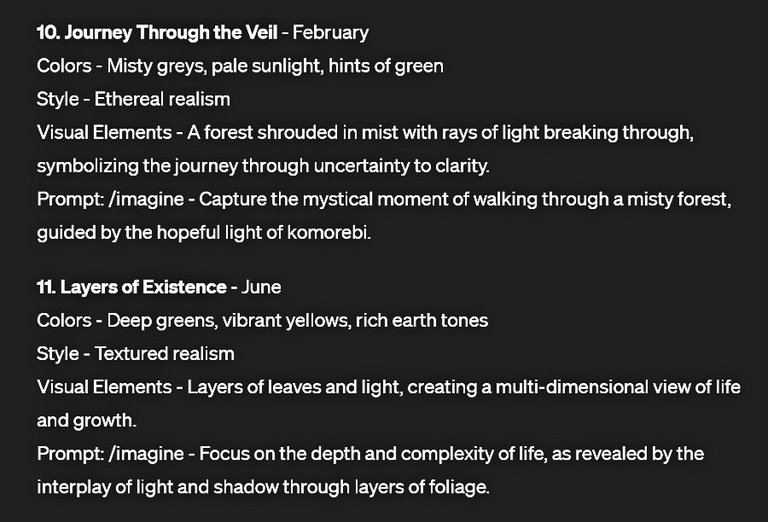
Generating the Images
I generate all my images in Midjourney using it on my Discord server. Midjourney has recently released a web interface. It’s not something I’m interested in using.
During the months I’ve been using Midjourney, I’ve built lists of styles and prompting styles to try when creating images. I love using them and experimenting with image styles. Most days I have 50-100 images to select from after I’ve generated the prompts.
There are many images I really like and don’t use for the Echoes. Many of them will be used in the future on one of my sites as merch like mugs, wall hangings, journals, puzzles, etc. Looking forward to getting them underway.
Selecting the Images
When the images are generated, I then start to sort through to select images to use. Usually I’ll review the material I’ve entered into my reference note in Obsidian at this point. Taking the time to do so helps me to develop a clearer image in my own head of possible ways to present the word. Some days, I really struggle to get a visual sense of the word. Sometimes, I think I have it but the analysis shows me I didn’t. It’s a learning process and one I’m grateful for.
When I get the list of images to ten or less, I download them. These are the ones I’ll have ChatGPT do an analysis on.
Back to the Komerebi example. After reviewing my note I realized I’m looking for something more than just sunlight through the trees, but what exactly, I wasn’t sure. A peaceful, introspective scene was a possibility.

I came across imagery using vivid colours and stain glass effect. One of them caught my attention. You could view the image as stain glass with a woods effect or trees with a stain glass effect. I selected it. The sunlight wasn’t obvious. Maybe it might fly, though.
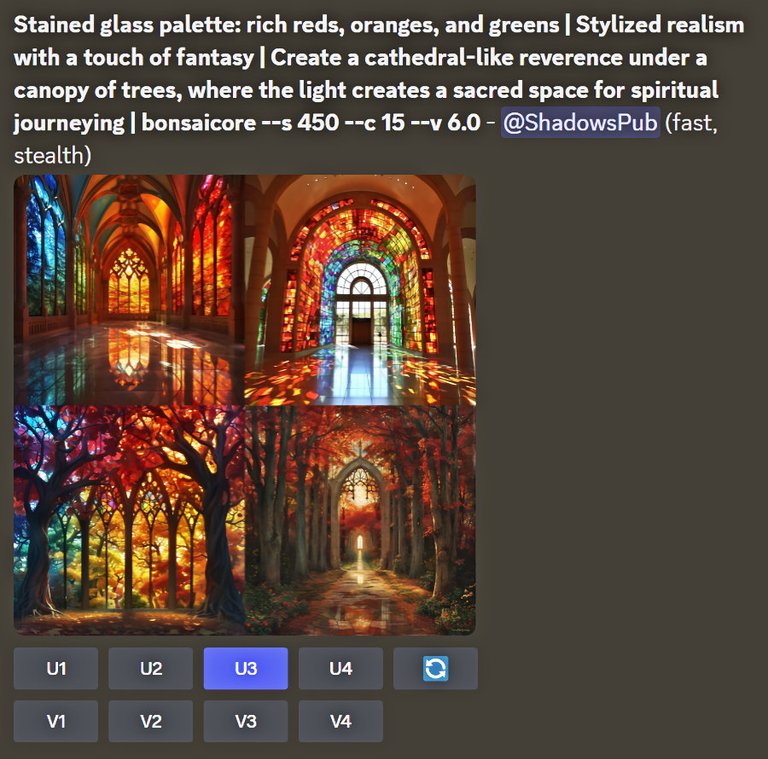
On the nature side of the imagery I found two panels showing fall colouring and lighting. The first one struck me as rather ordinary. Maybe with living in the area of the world I do, it was just too run of the mill.
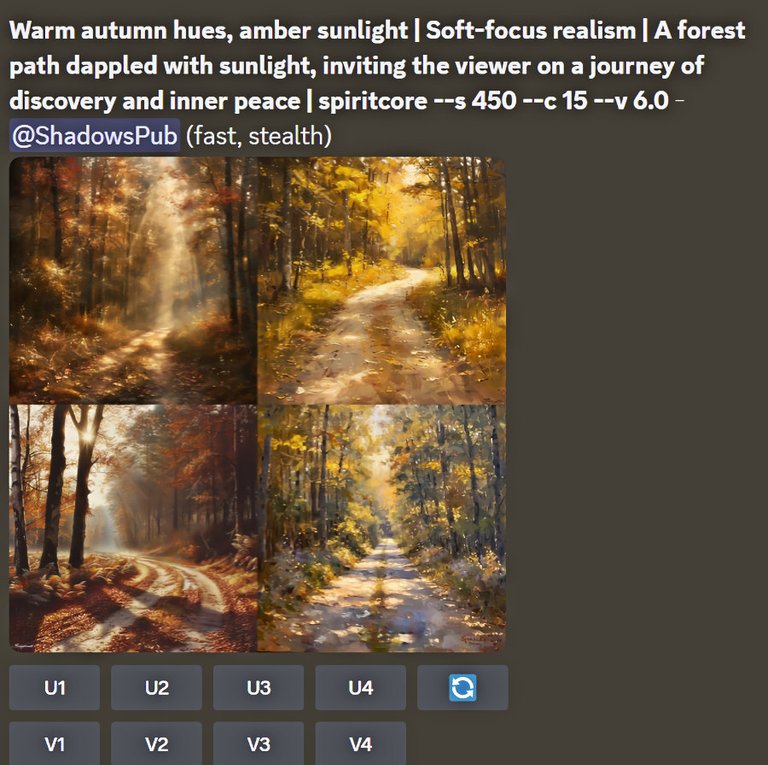
Then I came across a panel where there was a vibrancy, almost a glow to the colours and the setting. I chose one of those images I liked.
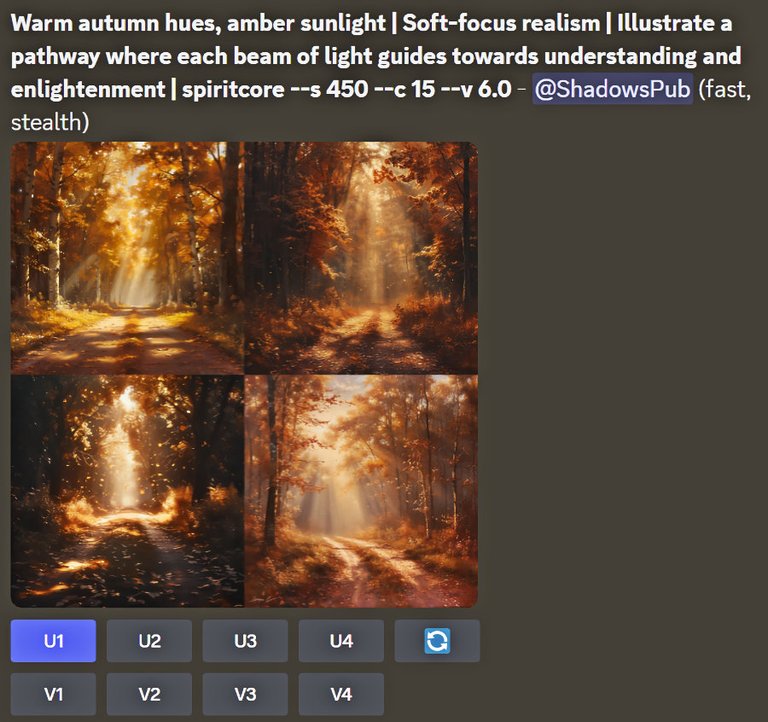
I found enough candidates to see how they would do on the analyzer.
Analyzing the Images to Select The “One”
Now, it’s back into the Echo Image Analyzer prompt. As I upload each image it ‘reads’ the image and tells me:
- a detailed description of the image
- an explanation of the symbolism found in the image
- its ranking for its representation of the word
- how the image resonates with personal growth and spiritual journey
Seven of the images I selected received a 10/10 ranking for the image. That would seem like they are tied but the comparative ranking will narrow the selection down. The ranking lists the images from the strongest to the weakest for representing the word and also provides me with a ranking for the images’ representation of Personal Growth and Spiritual Journey, respectively.
Of the seven images ranked 10/10 for the image, six of them had ranked both personal growth and spiritual journey at 10/10. Theoretically, the first image is the strongest representation. The ranking is subjective. Less emotionally than if I was ranking them. But still subjective. I consider ChatGPT to be one opinion. Now it’s time for me to return to the images, review the analysis and draw my conclusion.
I chose the image with the stain glass effect. I’ll admit, I was biased toward it from the beginning. I reviewed the other five images to see if anything there caught my attention to change my mind. I stayed with my choice.
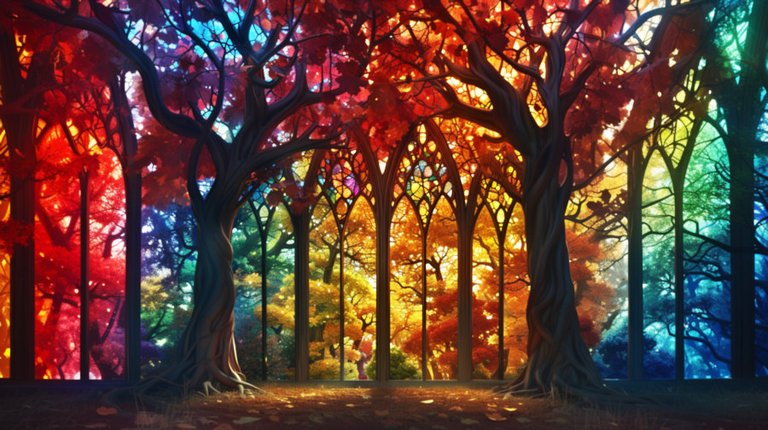
There are days my gut just tells me a particular image should be my choice. I still do the process and see where my ‘fav’ lands. I’m pleased the number of times my gut choice ends up being a good choice.
I use Midjourney to create a rectangular version of the image using its outpainting feature. This gives me a square image for sites like Instagram and rectangular for sites like LinkedIN. A light edit is done in my photo editing software and I add my signature to the images.
Developing the Quote
I now carefully read through all the notes. It’s time to create the quote for the image. With just a few words, I’m wanting to convey a sense of what the word means, and what the image represents. An economy of words really helps.
When the quote seems to be ready, I copy it into Gemini and ask for its thoughts on the quote. I will ask ChatGPT the same, but Gemini is more helpful to start with. It will respond by telling me what it considers being strengths of the quote and what it thinks I’m saying. Then it may suggest ways I could strengthen the wording.
"Komorebi, an experience of the sacred in nature, is light dancing through the trees' canopy, lighting a path of introspection and contemplation." -- ShadowsPub
This is an important feedback for me. I’ve had many days where, after considering Gemini’s suggestions, I change one word and end up with a much stronger, more evocative quote. After refining the quote with Gemini, when I ask ChatGPT for its thoughts, the answer I get is more useful.
With the images and the quote ready, I can now distribute my Daily Echo.
Developing the Reflection
I’ve not written a reflection for Komorebi. I’ll talk in general about how I create my reflections. If you’re keeping track of the list of prompts, I gave you at the start of this piece, you’ll notice there are four I’ve not talked about. They are all used to build my reference note before I writing.
The reflections in many ways are a learning time for me. They are me sharing my understanding, thoughts and feelings about my journey and how it relates to the quote I’ve just created. There are many writers and writings I’ve explored but not studied in depth. ChatGPT has been trained on a vast library of data and writings that include the topic of personal growth and spiritual journey.
I am a person of faith. I reflect that faith through the Christian tradition. I don’t see that tradition as an exclusive voice when it comes to living a life of faith. I’ve always strongly believed that Christianity is but one path and other paths have value to add.
The vast library of data AI has stored provides me an opportunity I’ve never had to tap into not only the writings, but those who have explored the subjects and written on them. Not directly. No AI would give me direct access to the writings, for that I need to locate the work and read it myself.
What it can do is use its vast knowledge and computing power to suggest how a tradition or writer might view a topic. The four remaining prompts help me to tap in.
One of the writers I’ve read, and value is Dr. David Hawkins. Among his writings, he developed a scale called the “Map of Consciousness”. It’s a scale he developed to measure where something or someone is at. It goes from zero, the least aware, to 1,000, the highest level of enlightenment where Buddha or Jesus would be. That’s a simplistic explanation, but I think you get the idea.

The Council of 5 prompt tells ChatGPT to take on the persona of 5 individuals based on what it knows of their works. For each word or quote I give it, ChatGPT is to respond using those personas to how it views the query and where it would register on the Map of Consciousness. The Spiritual Council prompt is very similar except it doesn’t use the Map of Consciousness and I have 8 different individuals named for ChatGPT to take on the persona of.
My experience with both these prompt results is they either validate my own ideas, give me concepts I’d not thought of, or perspectives I’d not used. If I want to explore deeper on any of the material, I can ask ChatGPT for references to their books and in particular the relevant parts of the books for me to read.
The last two prompts, Wisdom Traditions and Wisdom Scholar, add substance and depth to my reflections through the viewpoints of the Wisdom traditions like: Christianity, Judaism, Hinduism, Indigenous cultures, Philosophy and others.
I start by entering the quote I create into Wisdom Traditions and asking ChatGPT to provide a likely viewpoint based on it’s knowledge of the traditions. I also ask for it to provide me with at least one further reference and to point to the relevant parts of the reference. It concludes its response by telling me where the viewpoints are in alignment with each other and the quote, where they disagree and how they disagree.

Finally I use the Wisdom Scholar to ask questions based on the viewpoints and references given to me in the Wisdom Traditions prompt. When I conclude the questions I want to ask, I then invite ChatGPT to give me a similar summary and suggest any reference or viewpoint not yet suggested.
Then I Write A Reflection
All the data from the prompts is compiled into my reference note in Obsidian. I carefully work through it. As I read and explore the notes, I’m forming an idea of what I want to reflect on and to share.
I believe when we explore our journey with introspection and awareness, we’re constantly growing. Growth takes gaining knowledge and then integrating knowledge into our own life journey through examining how it influences our ideas, thoughts, behaviours and values.
What I’m sharing with my readers is not life’s instructions. It’s reflections on what I’ve learned and what it means in my life journey. If what I write resonates with a reader and turns a light on for the reader to explore what the light means in their life, then I’ve successfully shared with another.
My use of AI is to save time and allow me to create more content in a shorter time. It doesn’t mean I neglect reading source material. I’ve always been a learner through reading. I doubt that will ever change.
Making Sure It's My Writing
It’s important to me that what I publish is my writing, my thoughts, my voice. After using AI as my assistant, it’s important to me to make sure I don’t let its voice sneak into my writing. To check myself on that, I have my work scanned at Originality.ai where it’s checked for AI influence, plagiarism and facts.
Has This Been Helpful?
I hope this has been helpful. A peek into how I use AI to help me create at greater speed than otherwise possible. Many view AI as a glorified search engine. Use thoughtful prompts and it can do much more.
How about you? Have you been using AI? I don’t consider myself an expert, but I have learned a few things over the months. Ask questions and I’ll do my best to answer you.
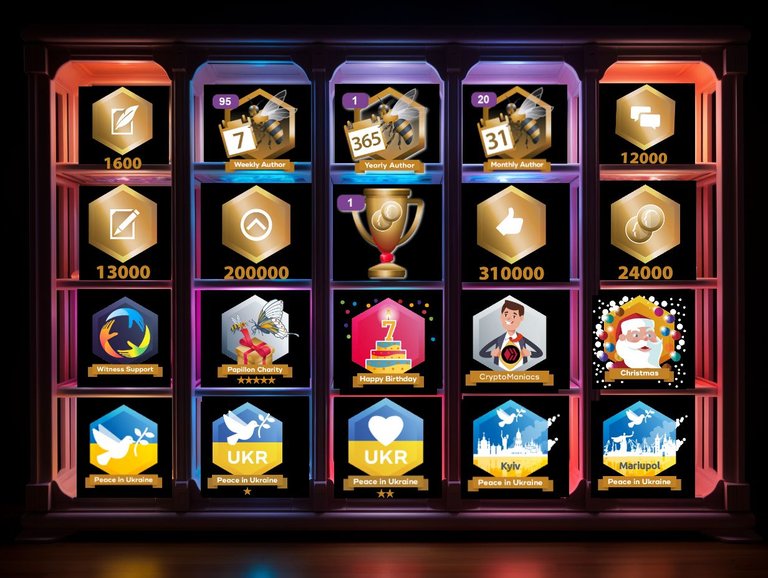
Shadowspub writes on various subjects as she pursues her passion for learning. She also writes on other platforms and enjoys creating books you use, like journals, notebooks, colouring books, etc. Her Nicheless Narrative podcast airs on Thursdays each week.
NOTE: unless otherwise stated, all images are the author’s. AI generated images were in Midjourney, for which I hold a licence to use the images commercially.
How to Connect With ShadowsPub:
Visit me at Shadows Central to find out what I’m up to.
Pimp Your Post Thursday (PYPT):
join us on the DreemPort Discord12pm EST Thursdays
Get eyes on your content and meet new friends. Join DreemPort.
I want to talk about a particular thing you said about thinking of the pictures to add to your writing.
I think one of the powerful skill most writers possess is being able to bring out a picture from what they write.
Pictures add so much to the story and it’s sad that this particular skill is always underrated
Wow that sounds so cool and impressive, it's really meticulous work. In my country I can't use AI like that and I feel like an abandoned passenger in a port watching from a boat
You outlined a lot.
Best wishes
I think this was discussed a little on Thursday in PYPT and I was so amazed how you're able to utilize these tools for your work. There's a lot one need to learn on this digital age.
Popped in from #dreemport